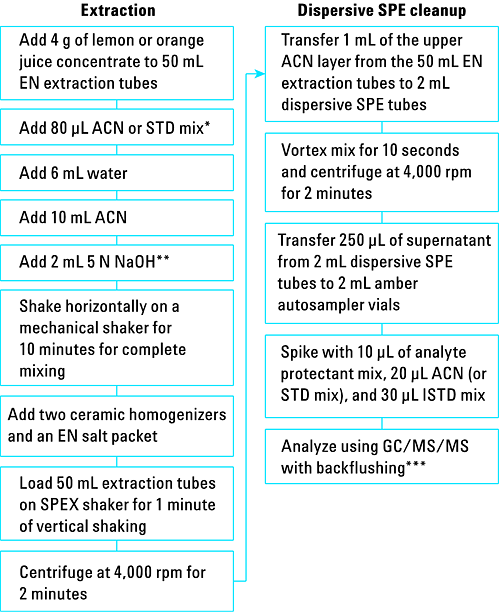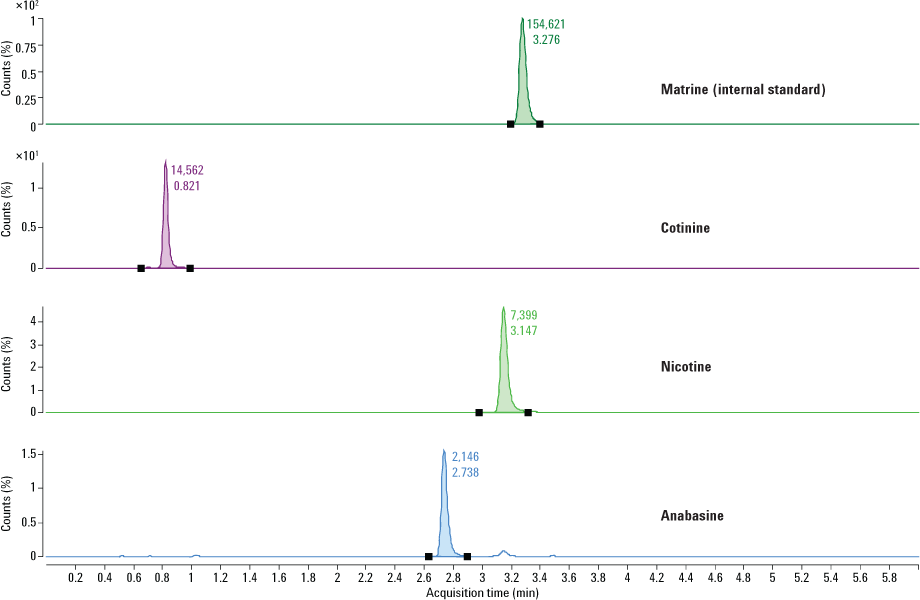Access Agilent eNewsletter, February 2014
>> Update My Profile | Subscribe to Access Agilent | Article Directory
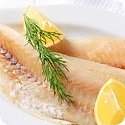
Easy, accurate pesticide residue testing in foods with Agilent Bond Elut QuEChERS Sample Preparation
By Kathy Mills
Agilent Global Marketing Program Manager, Food
There are many guidelines issued by regulatory organizations around the world developed specifically for the food and beverage industries. Sometimes, however, issues arise when dealing with uncommon or complex sample matrixes. To demonstrate the versatility of Agilent’s food safety applications, two very different pesticide classes were analyzed in two very different food matrixes, using two different analytical techniques (Full details are found in the Agilent Application Notes 5991-3342EN and 5991-2408EN).
Testing for pesticide residues in fruit juice
Preparing juice concentrate samples for Gas Chromatography Mass Spectrometry (GC/MS) analysis of multiclass pesticide residues can be challenging due to the extreme chemical and physical conditions of the sample. As an example, juice concentrates from lemon can be very acidic or very thick due to a high concentration level.
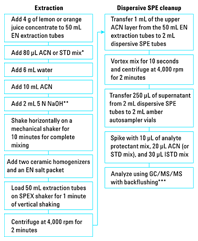 Enlarge
Enlarge
Figure 1. Schematic workflow of an optimized Agilent Bond Elut QuEChERS method for lemon and orange juice concentrates with unknown properties.
Agilent Bond Elut QuEChERS sample preparation optimization overcomes these problematic variables and significantly improves data quality. Figure 1 shows an optimized sample prep workflow, which included selecting the right combination of extraction and dispersive SPE products, pH optimization, and identifying the correct amount of sample. Each optimization step resulted in a better peak shape and sensitivity for the majority of analytes. This was especially important when dealing with traditionally problematic pesticides, such as captan and folpet, which gave excellent recoveries and R2 values in their matrix-matched calibration curves.
In this example, an Agilent Bond Elut QuEChERS EN extraction kit and the Agilent QuEChERS dispersive SPE kit for fruits and vegetables was used for sample prep. GC/MS separation was achieved with Agilent J&W HP-5ms Ultra Inert columns fitted to an Agilent 7890A GC with an Agilent 7000 Triple Quadrupole GC/MS System.
The use of analyte protectants (APs) for this particular application was essential for achieving good chromatography. APs can provide similar benefits for other types of complex matrixes prepared using this QuEChERS workflow. The identification and flexibility of the variables identified could help improve performance in other matrixes [1].
Measuring insecticide residues in fish
Nicotine, one of the most widely used botanical insecticides, is easily extracted from tobacco for Liquid Chromatography Mass Spectrometry (LC/MS) analysis. Although it is banned in the European Union – and the US Environmental Protection Agency (EPA) ordered its cancellation as of January 1, 2014 – bioaccumulation of nicotine in fish is likely to continue. However, there are straightforward sample prep and analytical methods for nicotine and its metabolites in fish, using hydrophilic interaction chromatography (HILIC) for these polar compounds.
In this example, Agilent Bond Elut QuEChERS AOAC extraction and QuEChERS dispersive SPE kits were used for sample prep. Separation was achieved using an Agilent Poroshell 120 HILIC LC column fitted to an Agilent 1290 Infinity LC with Agilent 6460 Triple Quadrupole LC/MS.
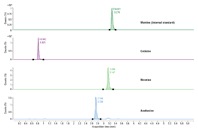 Enlarge
Enlarge
Figure 2. MS chromatogram of nicotine, its metabolites, and internal standard at 5 ng/g of fish.
Chromatographically, all compounds were baseline separated. Matrine, the internal standard, was retained close to nicotine with the Poroshell 120 HILIC column (Figure 2). Analytes of interest showed excellent linearity (R2 ≥ 0.998) within the concentration range of 1 to 500 ng/g in fish.
Without requiring special tools or accessories, up to 48 fish samples were processed in 20 minutes or less – by just shaking, vortex mixing, and centrifugation. Accompanied by a superficially porous Poroshell 120 HILIC column, good chromatographic separation was achieved for all of these polar compounds, with excellent linearity in calibration and recovery data [2].
Global solutions for global problems
As food supply chains become increasingly global, laboratories need to monitor a wider range of pesticides than ever before. This requires the measurement of hundreds of compounds in a number of different analyses, as well as multiresidue processes and sample preparation techniques that are both accurate and cost-effective.
Combined Agilent LC/MS and GC/MS multiresidue methods cover most compounds of interest to food analysts, and Agilent also offers proven sample preparation strategies to produce extracts suitable for both techniques.
Faster sample prep makes labs more productive
These are just some examples of how Agilent Bond Elut QuEChERS sample preparation kits can help laboratories achieve faster, more rugged, and high-throughput sample preparation methods. As the versatility of this technique reveals new applications for QuEChERS, a growing number of laboratories will benefit from fast, effective, and easy sample preparation strategies. Visit our web page for an overview of Agilent’s full selection of QuEChERS Kits and take full advantage of our free resources, including e-seminars, tips and tools.
References
- M. Chang. A QuEChERS Strategy for Juice Concentrates with Unknown Properties Analyzed by GC/MS/MS. Application note, Agilent Technologies, Inc., Publication number 5991-3342EN (2013).
- M. Chang. Modified QuEChERS for HILIC LC/MS/MS Analysis of Nicotine and Its Metabolites in Fish. Application note, Agilent Technologies, Inc., Publication number 5991-2408EN (2013).
>> Update My Profile | Subscribe to Access Agilent | Article Directory
